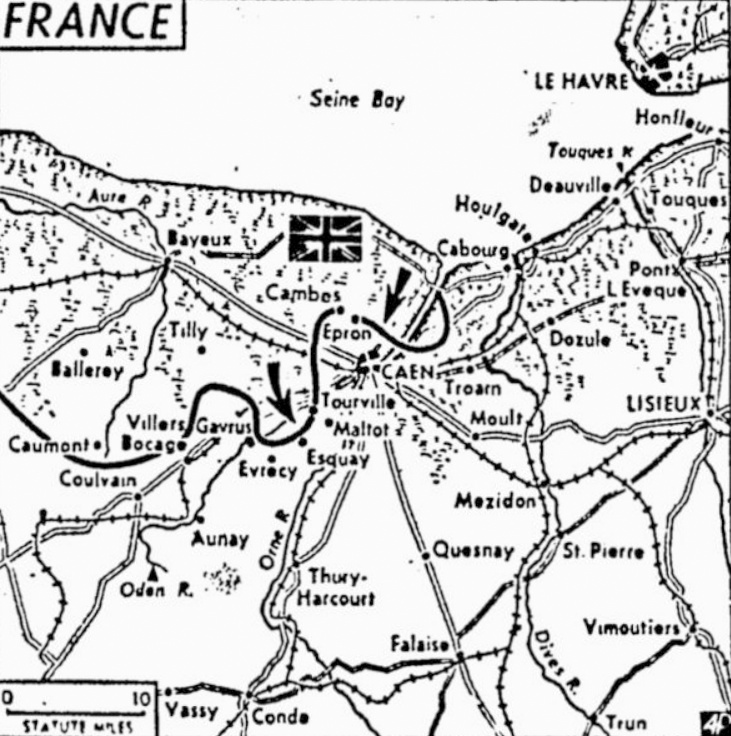The Pittsburgh Press (June 29, 1944)

Roving Reporter
By Ernie Pyle
On the Cherbourg Peninsula, France – (by wireless)
The American soldiers here are impressed by the loveliness of the Normandy countryside. Except for swampy places, it is almost a dreamland of beauty. Everything is so green and rich and natural looking.
There are no fences as such. All the little fields are bordered either by high trees or by earthen ridges built up about waist high and now, after many centuries, completely covered with grass, shrubbery, ferns and flowers.
Normandy differs from the English landscape mainly in that rural England is fastidiously trimmed and cropped like a Venetian garden, while in Normandy the grass needs cutting and the hedgerows are wild and everything has less of neatness and more of the way nature makes it.
The main roads in Normandy are macadam and the side roads gravel. The roads are winding, narrow and difficult for heavy military traffic. In many places we’ve made roads one-way for miles at a stretch.
The average American finds the climate of Normandy abominable, even in June. We have about one nice day for every three bad ones. On nice days, the sky is clear blue and the sun is out and everything seems wonderful, except that there is still a hidden chill in the air, and even in your tent or under a shade tree, you’re cold.
And on the bad days, the whole universe is dark and you need lights in your tent at noontime, and it drizzles or sprinkles, and often a cold wind blows, and your bones and your heart, too, are miserable.
Most everybody has on his long underwear. I wear four sweaters in addition to my regular uniform. Overcoats were taken away from our troops before we left England, and there are a lot of our boys not too warmly clad.
There is a constant dampness in the air. At night you put your clothes under your bedroll or they’re wet in the morning. All this dampness makes for ruddy cheeks and green grass. But ruddy cheeks are for girls and green grass for cows, and personally I find the ordinary American is happiest when he’s good and stinking hot.
It is the custom throughout our Army, as you doubtless know, for soldiers to paint names on their vehicles. They have names on airplanes, tanks, jeeps, trucks, guns and practically everything that moves.
Sometimes they have girls’ names, and often they are trick names such as Sad Sack, or Invasion Blues or Hitler’s Menace.
Well, the boys have already started painting French names on their vehicles. I saw a jeep named Biento, which means “soon,” and a motorcycle named Char de Mort, which means “Chariot of Death.”
Pretty soon we will be seeing jeeps named Yvonne and Ma Petite Chérie.
The names of a lot of the French towns in our area are tongue twisters for our troops, so the towns quickly became known by some unanimous application of Americanese. For instance, Bricquebec is often called Bricabrac. And Isigny was first known as Insignia but has now evolved into Easy Knee, which is closer to the French pronunciation.
I heard a funny story of one of our young fighter pilots who had to bail out one day recently high over the English Channel.
It seems the pilots carry a small bottle of brandy in their first-aid kits, for use if they are in the water a long time or have been hurt in landing.
Well, this young pilot, once he was safely out of his plane and floating down, figured he might as well drink his before he hit the water. So, he fished it out of his pocket and drained her down while still many thousands of feet in the air.
At high altitude, liquor hits you harder than at sea level. Furthermore, this kid wasn’t accustomed to drinking. The combination of the two had him tighter than a goat by the time he floated down into the channel.
A destroyer had spotted him coming down, and it fished him out almost as soon as he hit the water. Even the cold plunge didn’t sober him up. He was giddy and staggering around and they couldn’t keep him in one spot long enough to dry him off.
The captain of the destroyer sensed what had happened, and being afraid the kid would take cold wandering around the deck, he came up and said with affected harshness, “What the hell are you doing here? Get below where you belong.”
Whereupon the wet young lieutenant drew himself up in indignation and, with all the thick-tongued harshness of a plastered guest who’s been insulted by his host, replied: “I assure you I don’t propose to remain where I am not wanted.”
And forthwith he jumped overboard. The destroyer had to rescue him again.


